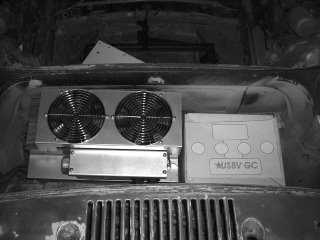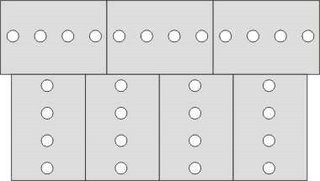AC Controller Mounting Options
And then, I had a different thought: "what if the controller were placed in the *front* of the car?" I measured from approximately where the motor will go, along the driver's side heater tube, and into the gas tank compartment, and it came out to about 8 or 9 feet. So, it would fit. Additionally, looking at the controller manual, it looks like all the control signals it wants are more easily available near the dashboard than in the engine compartment (you could even consider a short throttle cable and put the potbox in the gas tank compartment). So I tried it. It fits – even allowing some extra height for mounting brackets and the rubber anti-vibration feet:

Top view: room for a battery plus battery box

Side view: room for 144v power input cables to come in

Side view: room for controller cabling and routing of main motor power cables
That leaves the question of what to do with the gas tank batteries. I came up with a few options:
- The controller manual says it can operate at a nominal voltage of 120V. So, one option would be to delete the gas tank batteries altogether, leaving 15 8-volt batteries at 120V system charge. The disadvantages are probably a 20% lower range and 30% lower top speed. The advantages are the: the least amount of change to the existing AC kit, and the savings of nearly 200 pounds in weight (and the lack of big holes in the rear trunk area to let water in). Additional disadvantages are a need to recalibrate the charger and DC-DC converter.
- Assuming it would be better to stay 144 volt, the option that keeps the AC kit most similar to the DC kit would be to re-add the saddlebag batteries (2 of the 3 that need to be placed) and leave the third battery in the gas tank (as the mockup pictures show). It would require a little custom mounting hardware for the battery box in the gas tank – it might be able to combine that with the mounting hardware for the controller. The advantages are: 144 volt system design, uses parts you have in your inventory for the DC kit. The disadvantage seems to be mostly in some asymmetry with respect to weight distribution: a battery weighs 65-70 pounds, whereas the controller only ways about 32 pounds. If one puts the 12-volt battery on the driver's side instead of the passenger's side, and if one biases the recharger toward the driver's side, that would compensate to a large amount.
- A third option would be, like #2, to add back in the saddlebag batteries but to redesign the front battery compartment to hold 7 batteries instead of 6. Either in a 5-2 configuration (which I'm not sure would fit - see "Batteries5-2.jpg"):

or a 4-3 configuration (see "Batteries4-3.jpg"):

The main advantage this has over #2 is better weight symmetry. The disadvantage is extra custom AC kit parts in your inventory. Also, it puts even more weight in front of the wheels, which I don't really like. And, I don't really know whether either configuration would fit.
All three options would require taking the battery cables from the rear comparment up the *passenger's* side heater tube (since the motor and controller most naturally would use the *driver's* side based on their native asymmetries).
Just some idle thoughts. Any of them would eliminate having to come up with a highly customized controller mount. And all three of them keep the controller more protected from the elements. And, from the length of the control and power cables on the motor, it looks kind of like the direction Solectria was going.
So, what do you think? Are any of these worthy of consideration? My favorite is #2, for what it's worth.

Comments